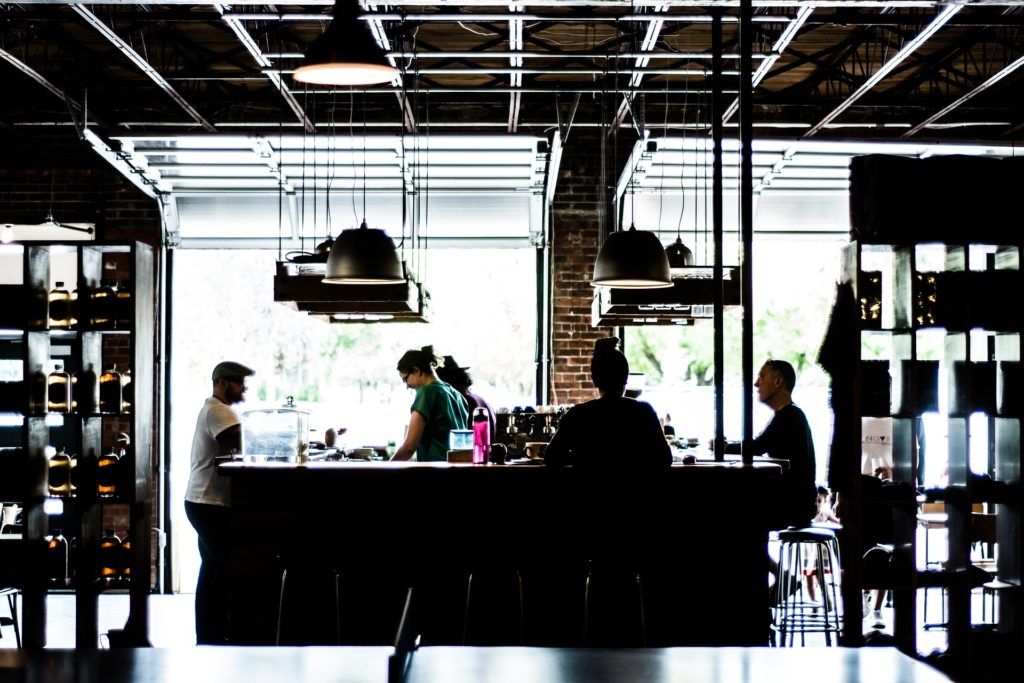Starting your own small restaurant or cafe can be a dream – but you’ll need help along the way, along with some starting capital. Our friends at Fundera offer some answers to the funding question with this guestpost below, answering frequently-asked questions about restaurant financing.
Whether you’ve always dreamed of opening your own restaurant or you’ve been behind the grill for years now, you probably already know that running a restaurant is hard work. But the good news? For the most part restaurant success rates are in line with the success rates of all other small businesses.
The biggest difference is that restaurants often operate with slim profit margins—ranging from 6% to just 2%. Slim margins can lead to cash flow issues, and a lack of startup or operational capital is often cited as one of the most common reasons restaurants fail.
How can I get a loan for a small restaurant?
When you need capital, business financing can be a great choice to meet financial goals and grow your restaurant. Funding via a term loan, line of credit, equipment financing, or even a business credit card can help you afford important equipment upgrades, cover payroll, start a new location, or bankroll emergency repairs.
Whether you’re new to business funding or you have taken out a loan before, you may have lots of questions about the nature of restaurant financing. Here are all your restaurant financing questions, and the answers for address them:
Do I need restaurant financing?
The decision to take out financing should never be taken lightly. If your restaurant is a healthy, stable business with excellent margins, and you can afford to grow without taking on debt, that’s the way to go.
Is it easy to secure funding for a restaurant?
It may be harder than you expected to secure financing: You typically need to have a well-established business, with excellent credit history, and adequate collateral to be considered for loans with generous terms . But if you do the work to secure a loan, the payoff of not using equity financing—which involves selling pieces of your venture and potentially giving up complete control of your restaurant, including decisions on menu, marketing, and expansion—is worth the effort.
If you do think that you’ll need funding at some point, start planning for it now: Create a viable business plan and figure out whether funding might help you accomplish those goals. Some forms of funding require months of planning anyway.
How soon will I need the money for my restaurant?
The absolute best forms of financing—SBA loans, for example—can take weeks or months to go through and complete the application process. It’s an arduous process, but as a result you receive low interest rates and generous repayment timelines if you qualify.
(Editor’s Note: SBA loans are available to small businesses in the United States, from the U.S. Small Business Association. It is worth identifying the availability in your country.)
If you financing needs are more immediate, that changes the equation. You can apply for some forms of financing that fund in just one or two business days. These credit options may not have the same interest rates as a long-term loan, but they are helpful when your business is in a pinch.

Managing finances is important – and often mentioned in the best restaurant management books
What are the options for financing my restaurant?
You have a number of debt financing options if you own a restaurant, though you’ll be more qualified for some than for others depending on factors such as your business credit score, time in business, and personal credit.
Term loan
A term loan is what you probably consider when you think of business loans: A lender, either a bank or an online lender, extends you funding, and you pay it back over regular weekly or monthly installments, with interest.
Although banks are often reticent to extend loans to small businesses, you’re more likely to be considered if you’ve been in business for at least 4-5 years and have healthy margins. Restaurants typically have at least one thing that most lenders like to see—lots of daily transactions—and so if everything else is above board, you may be considered.
If you are a newer business, need funding quickly or have less-than-stellar credit, a short-term loan may be a more realistic option for your business. These loans typically come with higher interest rates and quicker repayment terms than, for example, a long-term SBA loan, but you may end up paying less interest overall than you would with a long-term loan. The longer you pay back a loan, the more money you will pay in total interest over the life of the loan.
SBA loan
SBA loans—loans that are partially guaranteed by the Small Business Administration—are generous but competitive. As a result, their application process is extensive and time-consuming. If you need a loan with a quick funding time, other options (see below) will be a better fit.
The SBA has several loan programs that restaurateurs can qualify for. The biggest and most popular is the 7(a) program, the proceeds of which can be used for a number of needs including working capital and refinancing other debt. To apply, you’ll need to have at least two years in business, good to excellent personal and business credit, and a business plan with 3-5 years of financial projections. You may also need to meat loan-specific requirements, such as a producing an environmental impact statement for a 504/CDC loan.
There is also the SBA microloan program, which is good for startup ventures that can use $50,000 or less in funding. Microloans can be used as working capital, such as covering payroll or bankrolling a marketing campaign; or for buying inventory, supplies, furniture, fixtures, machinery, or equipment. The SBA microloan program looks to fund entrepreneurs who face systemic and historic disadvantages such as women and minorities, as well as veterans.
Equipment financing
One of the most common reasons restaurant owners look for financing is to buy new equipment, such as new commercial kitchen appliances, furniture, or a point of sale system. If that is your biggest need, equipment financing can be a great option for your business.
Equipment financing allows you to buy that new equipment without paying out of pocket: The lender advances you financing for the equipment, which then becomes collateral for the loan. You can fund either part of the equipment or the full 100%, depending on your needs.
Equipment financing is great for new restaurants or those with credit issues, since the loan is automatically secured without the need for additional collateral.
Line of credit
A business line of credit is a form of revolving credit, similar to a credit card. But most credit cards don’t have nearly the spending limits of LOCs, which can go as high as $1 million. You only pay for what you draw from a line of credit, and you can keep it in your back pocket in case of emergencies once you establish it.
Business credit card
A business credit card is an excellent tool for any small business owner to have, and restaurant owners are no exception. If you qualify, some business credit cards offer a 0% APR introductory rate that can act as an interest-free loan (at least through the life of the offer), and you can continue to use it to pay vendors and creditors to give yourself a little cash flow breathing room.
If you don’t qualify for a 0% APR, you can still use your credit card to cover financing costs—just make sure you pay off your expenses before you start accruing more interest than you can afford. Business credit cards also come with reward points and perks such as travel insurance and price protections.
Related Read: Should you finance your eCommerce buisness with a credit card?
Inventory financing
This form of financing is similar to equipment financing, but it’s the inventory that’s used as collateral instead of a piece of equipment. This form of financing is more difficult for restaurants than for other small businesses, mostly because restaurant inventory is typically food, which has a shorter shelf life than other consumer products—but it’s still a possibility if capital for inventory is your biggest need.
What about equity financing?
Loans such as the options above are considered debt financing: You go into debt into order to take on the funds, but once you pay your lenders off, you retain complete control of your business. Another form of financing is equity financing, where you raise capital for your business by essentially selling pieces of it off to investors, or making promises in exchange for their investment.
Equity financing takes several forms, including angel investors, venture capital firms, friends and family, and crowdfunding.
Angel investors and venture capital firms essentially trade their investments for financial stakes and potentially decision-making power in your business, while friends and family and crowdfunding platforms such as Lending Club may mean promising to pay them back at the earliest date, granting privileges, and other perks in exchange for their help.
How can I increase my chances of getting financing?
Obtaining financing for your restaurant isn’t easy, but there are some best practices you can follow that can improve your chances of qualifying for financing.
One is to focus on your personal and business credit—the higher your scores, the more likely you will be approved. Even if your margins aren’t very high, a lender will be more willing to take a chance on you if you have a demonstrated history of handling credit wisely.
Another is to seek out lenders who specifically work with restaurants, or focus on the particular goals you might have for your restaurant, such as franchising. This list includes ARF Financing and Apple Pie Capital, among others.
Additionally, if you’re approaching the end of the year and you plan on applying for financing in the next financial quarter, hold on to any extra profit rather than reinvesting it to avoid paying taxes on it. Showing that extra profit on your tax return is much more compelling to lenders than showing next-to-nothing in the bank.
There may be other little steps that you can take to increase your chances. Talk to your accountant to see what might work in your specific case.
Important things to know for restaurant financing
Getting approved for business financing isn’t an easy task, but the effort in doing so is worth it if the extra funds can grow your business. Having that extra capital on hand could be the difference between making payroll one month or not, or expanding to a new location when the momentum for your brand is at its peak. If financing is the right move for your business, it’s important to understand your options and decide what type of funding suits your needs best.
Eric Goldschein is a staff writer at Fundera, a marketplace for small business financial solutions, covering entrepreneurship, small business trends, finance, and marketing.


